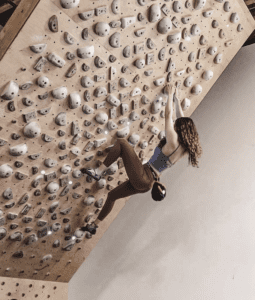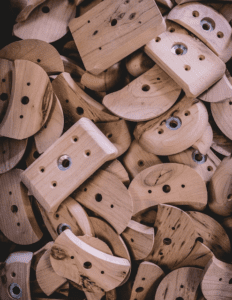Tension Board versus the MoonBoard
We analyze the Tension Board and compare it with the popular MoonBoard. Wood versus plastic, symmetry versus the asymmetrical

Several weeks ago, we spent time analyzing the 2017 MoonBoard set. The 40-degree benchmark generator was generally praised for its effectiveness as a training board as we explored the various intricacies of its function.
Though the MoonBoard is a useful tool, it is not the only climbing board that allows an athlete speedy progression. Tension’s self-titled Tension Board is perhaps one of the most radical, training systems available today. Today, we explore how it differs from the Moonboard.
What is a Tension Board?
Tension Climbing was founded in 2015 by Will Anglin and Ben Spannuth. The Colorado-based designers were tired of the sharp plastic edges that typically defined the training walls. They were determined to do something about it.
Since its inception, Tension Climbing has sponsored some of the world’s strongest athletes and has built some of the world’s best training products. Though the Beastmaker 2000 is an exceptional standardized training tool, its edge sizes are negotiable between boards and the system lacks the precision one might typically expect from a training tool. Tension’s Grindstone models do not suffer from this problem.
The Grindstone Hangboard, along with all of Tension’s products, holds a focus on precision. The hangboard is measured and made of the highest quality materials. Unless you are specifically trying to build skin on the Transgression hangboard, Poplar-based training products are the best for increasing grip strength. This is because of wood’s low-friction texture. The climber must engage on the holds to train at their limit. They are not able to use the tensile strength of their skin to complete a hang.
Taking this concept further, the climber will ask the question, “Should I climb exclusively on wooden holds to build grip strength?” According to Tension, yes. Enter: the Tension Board.
Symmetry
There are two great differences that separate the Tension Board from the MoonBoard. The first: the wooden holds. The second: the symmetrical layout. We will return to talking about the wooden holds in a moment and will now focus on the symmetrical design of the board.
To begin, it is symmetrical about the Y-axis. This is to say that if there is a horizontal pinch at a certain height on the right side of the board, there is another horizontal pinch at exactly the same height on the other side of the board. These grips are also the exact same distance from the middle of the board.
Why is symmetry important? To put it simply, it allows the climber to isolate and target their weaknesses. This is because any boulder problem that is set has a twin that is reflected over the y-axis.
Ideally, the athlete will climb both their set boulder problem and its reflection. What is interesting is that the beta for each climb is generally not a perfect reflection like the holds are. Frequently, in fact, the climber may be able to climb their project in one direction and find themselves unable to climb its reflection.
This suggests there is a right- and left-handedness to climbing. You may have noticed this when it comes to dynos and dead-points. Next time you are climbing think about which hand you would prefer to catch a hold with. Though the best of us might find that answer to be defined by the boulder problem, many will find that they want to catch holds with their dominant hand. Our editor is right-handed. They are stronger at catching holds with their right hand and has a preference for doing so.
The more you climb on the Tension Board, the more obvious your imbalances become. This allows the climber to think about improvement in a measured way. This function makes the Tension Board is an exceptional testing tool. If used as a training tool, the Tension Board requires the athlete to actively consider their weaknesses. This is a strength and weakness of the board.

The Holds
The Tension Team puts an emphasis on precision. The wooden grips of the Tension Board further this concept. If you have never climbed on wooden holds before, the experience is rather different from plastic holds.
At first, you will realize that there is no “hanging” on your skin, at least not in the same way. Where a brand new Flathold will fully exfoliate your tips, it is almost impossible to scrape through your skin on wooden holds. This forces the climber to grip with intent. It asks the climber to consider the consequences of adjusting their grip on a hold. It is easy to dry fire off of wooden holds.
This creates a “present” experience. Though there are many ways to climb hard, precise movement paired with a high-level of grip strength is certainly one of the most effective. It is definitely the most trainable. To standardize this process, Tension has made regularly-shaped holds. This is to say that every hold is comfortable to grip. With that said, there are a few holds that are difficult to hold, but even still, the Tension Grips allow the climber to use a four-finger full-crimp, half-crimp, open-hand, or pinch grip on each and every hold. This is “ideal” for climbing and is most similar to a hangboard.
This has its advantages and disadvantages. In many ways, its strength is also its weakness. The climber is allowed to progress quickly in these regular grip positions. Every session easily builds on the previous session as each hold is more or less similar to the last. Each grip is either a sloper ball, a pinch or an edge. Though there are jugs, these are effectively just large edges.
On the other hand, most climbing holds outdoors are not regularly shaped. In fact, it is often rare that a grip is perfectly shaped. The relative significance of this fact is unclear. It could be argued that the Tension Board requires the climber to move so precisely, and to think so clinically, that they lose the creativity that some beta requires. Conversely, it could be argued that gym boulders provide this aspect of training and it therefor does not belong on a training board.

Comparison to MoonBoard
Ultimately, these two tools are rather different. They both have applications and online communities, but the similarities stop there. It is fair to say that many of the MoonBoard Benchmark problems are two grades more challenging than the Tension Board problems. With that said, the Benchmark problems do not accurately reflect difficulty. Even still, as a training tool, sandbagging is very useful.
Though there aren’t benchmarks on the Tension Board, Matt Fultz and Will Anglin have designed a plethora of problems that we can probably take as “benchmark.” Going to their setter histories can direct the athlete through a few of the classic problems. With that said, the greatest weakness of the Tension Board is its application.
Both of these set ups do offer LEDs that connect to your phone’s Bluetooth function, however the Tension Board’s LEDs appear to be higher quality. Additionally, many Tension Boards have adjustable angles allowing the climber to tailor their training to their project.
Ultimately, the conversation becomes a question: “Which board is better?” As grading is irrelevant to the board itself, it will not be considered. The unfortunate answer to this question is that each board is better than the other at different things.
The MoonBoard is a better tool for the climber seeking to master powerful, finger-intensive boulder problems. This is because the holds are oddly shaped and requires the climber to “make it work” unlike the more comfortable Tension Board.
To that effect, the Tension Board is a better tool for pulling power and precision. If you need to work on pulling hard, fast and far, the Tension board will help you get there. To that effect, the Tension Board does not allow you to mess about with your grip positions. It asks you to hit the hold and continue.
What should you do?
Honestly, climb on both. If you are a more advanced climber, the Tension Board will tell you more about your weaknesses than a MoonBoard ever could. The MoonBoard, however will teach you the most valuable lesson of power training: If you are stronger, bouldering is easier. For our editor, the Tension Board cultivates technical strength while the MoonBoard increases raw power.
With that said, both boards are exceptional training tools. Perhaps the most important aspect of these products is the fact that they are hard. They require the climber to grip hard, pull hard, climb well, and climb to the end. These lessons are not learned on most indoor boulder problems and are difficult to practice. If you want to climb harder, faster, sooner, either of these boards will change the way you climb.


